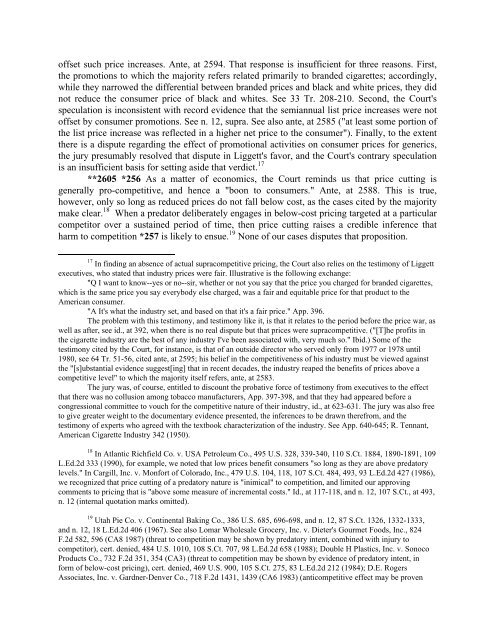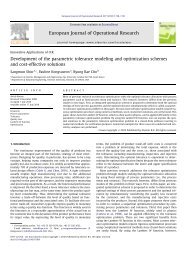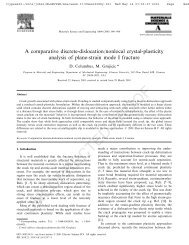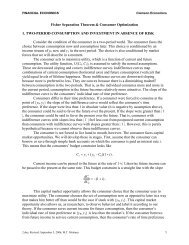509 U.S. 209, 113 S.Ct. 2578 BROOKE GROUP LTD., Petitioner v ...
509 U.S. 209, 113 S.Ct. 2578 BROOKE GROUP LTD., Petitioner v ...
509 U.S. 209, 113 S.Ct. 2578 BROOKE GROUP LTD., Petitioner v ...
You also want an ePaper? Increase the reach of your titles
YUMPU automatically turns print PDFs into web optimized ePapers that Google loves.
offset such price increases. Ante, at 2594. That response is insufficient for three reasons. First,<br />
the promotions to which the majority refers related primarily to branded cigarettes; accordingly,<br />
while they narrowed the differential between branded prices and black and white prices, they did<br />
not reduce the consumer price of black and whites. See 33 Tr. 208-210. Second, the Court's<br />
speculation is inconsistent with record evidence that the semiannual list price increases were not<br />
offset by consumer promotions. See n. 12, supra. See also ante, at 2585 ("at least some portion of<br />
the list price increase was reflected in a higher net price to the consumer"). Finally, to the extent<br />
there is a dispute regarding the effect of promotional activities on consumer prices for generics,<br />
the jury presumably resolved that dispute in Liggett's favor, and the Court's contrary speculation<br />
is an insufficient basis for setting aside that verdict. 17<br />
**2605 *256 As a matter of economics, the Court reminds us that price cutting is<br />
generally pro-competitive, and hence a "boon to consumers." Ante, at 2588. This is true,<br />
however, only so long as reduced prices do not fall below cost, as the cases cited by the majority<br />
make clear. 18 When a predator deliberately engages in below-cost pricing targeted at a particular<br />
competitor over a sustained period of time, then price cutting raises a credible inference that<br />
harm to competition *257 is likely to ensue. 19 None of our cases disputes that proposition.<br />
17 In finding an absence of actual supracompetitive pricing, the Court also relies on the testimony of Liggett<br />
executives, who stated that industry prices were fair. Illustrative is the following exchange:<br />
"Q I want to know--yes or no--sir, whether or not you say that the price you charged for branded cigarettes,<br />
which is the same price you say everybody else charged, was a fair and equitable price for that product to the<br />
American consumer.<br />
"A It's what the industry set, and based on that it's a fair price." App. 396.<br />
The problem with this testimony, and testimony like it, is that it relates to the period before the price war, as<br />
well as after, see id., at 392, when there is no real dispute but that prices were supracompetitive. ("[T]he profits in<br />
the cigarette industry are the best of any industry I've been associated with, very much so." Ibid.) Some of the<br />
testimony cited by the Court, for instance, is that of an outside director who served only from 1977 or 1978 until<br />
1980, see 64 Tr. 51-56, cited ante, at 2595; his belief in the competitiveness of his industry must be viewed against<br />
the "[s]ubstantial evidence suggest[ing] that in recent decades, the industry reaped the benefits of prices above a<br />
competitive level" to which the majority itself refers, ante, at 2583.<br />
The jury was, of course, entitled to discount the probative force of testimony from executives to the effect<br />
that there was no collusion among tobacco manufacturers, App. 397-398, and that they had appeared before a<br />
congressional committee to vouch for the competitive nature of their industry, id., at 623-631. The jury was also free<br />
to give greater weight to the documentary evidence presented, the inferences to be drawn therefrom, and the<br />
testimony of experts who agreed with the textbook characterization of the industry. See App. 640-645; R. Tennant,<br />
American Cigarette Industry 342 (1950).<br />
18 In Atlantic Richfield Co. v. USA Petroleum Co., 495 U.S. 328, 339-340, 110 S.<strong>Ct</strong>. 1884, 1890-1891, 109<br />
L.Ed.2d 333 (1990), for example, we noted that low prices benefit consumers "so long as they are above predatory<br />
levels." In Cargill, Inc. v. Monfort of Colorado, Inc., 479 U.S. 104, 118, 107 S.<strong>Ct</strong>. 484, 493, 93 L.Ed.2d 427 (1986),<br />
we recognized that price cutting of a predatory nature is "inimical" to competition, and limited our approving<br />
comments to pricing that is "above some measure of incremental costs." Id., at 117-118, and n. 12, 107 S.<strong>Ct</strong>., at 493,<br />
n. 12 (internal quotation marks omitted).<br />
19 Utah Pie Co. v. Continental Baking Co., 386 U.S. 685, 696-698, and n. 12, 87 S.<strong>Ct</strong>. 1326, 1332-1333,<br />
and n. 12, 18 L.Ed.2d 406 (1967). See also Lomar Wholesale Grocery, Inc. v. Dieter's Gourmet Foods, Inc., 824<br />
F.2d 582, 596 (CA8 1987) (threat to competition may be shown by predatory intent, combined with injury to<br />
competitor), cert. denied, 484 U.S. 1010, 108 S.<strong>Ct</strong>. 707, 98 L.Ed.2d 658 (1988); Double H Plastics, Inc. v. Sonoco<br />
Products Co., 732 F.2d 351, 354 (CA3) (threat to competition may be shown by evidence of predatory intent, in<br />
form of below-cost pricing), cert. denied, 469 U.S. 900, 105 S.<strong>Ct</strong>. 275, 83 L.Ed.2d 212 (1984); D.E. Rogers<br />
Associates, Inc. v. Gardner-Denver Co., 718 F.2d 1431, 1439 (CA6 1983) (anticompetitive effect may be proven
















